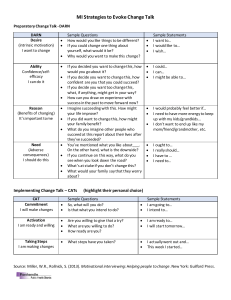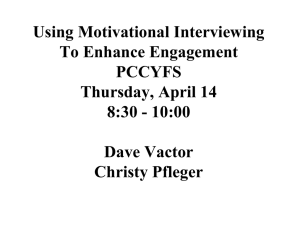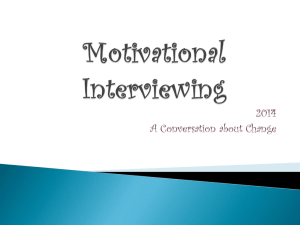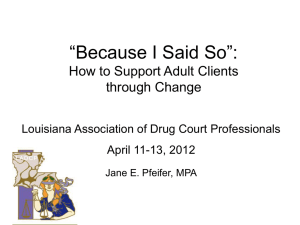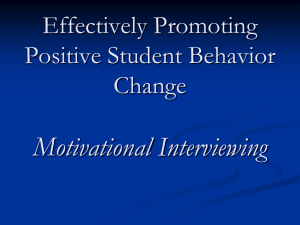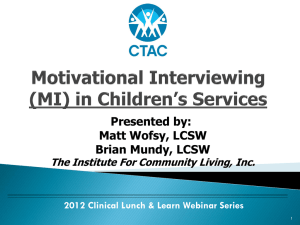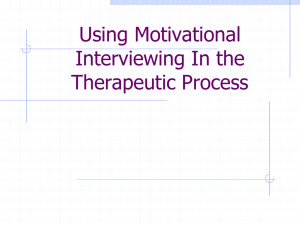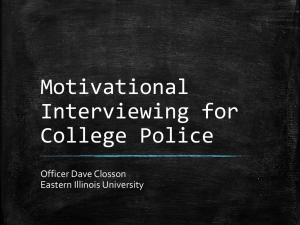Motivational Interviewing: Enhancing Engagement
advertisement
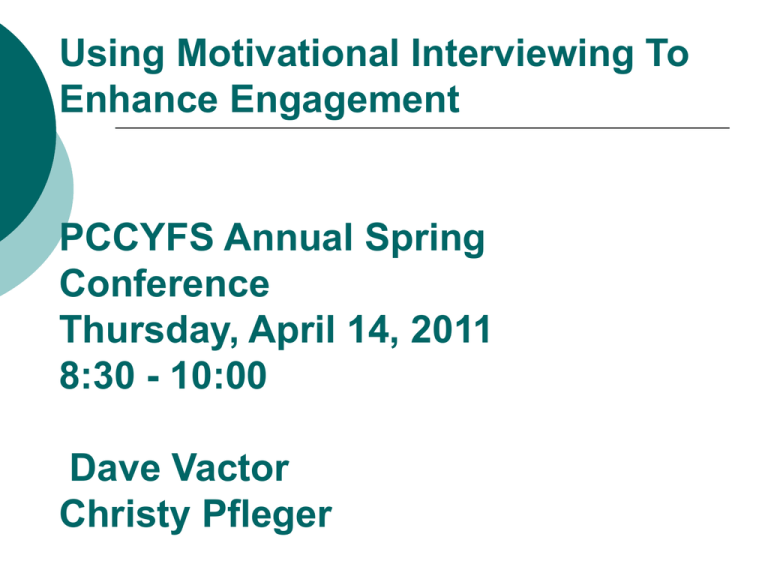
Using Motivational Interviewing To Enhance Engagement PCCYFS Annual Spring Conference Thursday, April 14, 2011 8:30 - 10:00 Dave Vactor Christy Pfleger “MI Preparation Prayer” Guide me to be a patient companion To listen with a heart as open as the sky Grant me vision to see through her eyes And eager ears to hear her story Create a safe and open mesa on which we may walk together Make me a clear pool in which she may reflect Guide me to find in her your beauty and wisdom Knowing your desire for her to be in harmony-healthy, loving, strong Let me honor and respect her choosing of her own path And bless her to walk it freely May I know once again that although she and I are different Yet there is a peaceful place where we are one -Bill Miller, co-founder of MI, Rollnick and Miller 1995 Purpose Provide an overview of the process of change and basic MI skills Explore how to use MI skills to effectively engage families Learn strategies to help clients tap into their motivation for change So What Exactly is MI? Definition: a perspective that views a client as the most influential agent of change and aims to empower the client to actively engage in the process of change. a method or approach, not a technique, that is not based on a singular theory. “A directive, client-centered counseling style for eliciting behavior change by helping clients explore and resolve ambivalence.”-Rollnick and Miller, 1995 Rollnick and Miller 2006 Benefits of using MI Address and move past ambivalence Motivate towards change Helping the decision making process Address and decrease resistant behaviors History MI was developed in 1983 by Bill Miller for use with substance abuse clients. Empirical data has been collected for use of MI treatment with: drug and alcohol abuse, smoking cessation, psychiatric disorders, HIV related risk behaviors, diet and exercise. Note: These effects did not diminish significantly over time. Beliefs Essential to the MI process Person-Centered (closely linked to Rogerian Theory) Resistance to change and ambivalence are natural human processes • Lack of motivation=unresolved ambivalence • Negative feelings and experiences can inhibit change • Change occurs when it is connected to something of importance and value The client needs to show you the reason for change in order to proceed successfully (“change talk”) “Change Talk” What people say and how they talk about change is important. Defensiveness = Confrontation = Change Change Confidence and Self-Efficacy When people and service providers believe that change can happen, it is more likely it will happen Self-efficacy=hope that change can occur Empathy facilitates change Positive reinforcement increases likelihood of trying new behaviors Sets up the collaborative relationship “Friendly consultant” role Approach Direct persuasion is not an effective method for resolving ambivalence Increases resistance behaviors, decreases willingness for change The style is generally a quiet and eliciting one Focus is on drawing out from the client, and providing guidance through questions, scaling, etc. 60/40 Approach, continued o The counselor is directive in helping the client to examine and resolve ambivalence o Readiness to change is a not a client trait, but fluctuating product of interpersonal interaction • Resistance and denial are a product of the client’s interactions with the world around him, not a personality trait Three Key Components Collaborate Empathy, respect Evocation (Draw Out) Guided questions, reflection Autonomy (Partner) (Client stands on own) Implements and sustains change Identifying “Change Talk” Disadvantages Advantages of status quo of change Optimism Intention to change What is Unique about MI? MI is Directive Client-Centered= focused on client’s interest and concerns • MI is a method of communication • Do not teach new skill, alter thought patterns or look to the past Not something we do to, but we are with and for clients Change is not forced or imposed (i.e., through punishment, pressure, financial gain) The client is the expert to their situation Wheel of Change Motivational Interviewing and the Trans-theoretical model to change were developed separately but synchronously. • Trans-theoretical model of change is used to breakdown the concept of readiness to change into stages. The Wheel of Change was created to to assess what MI strategies to use for forward movement. Prochaska, Di Clemente and Norcross, 1992 Wheel of Change Based on self-help change, but applies to all types of change. Tool to help us understand where clients are in their cycle of change. Assists in engaging clients to help them want to change. Relapse is viewed as an inevitable stage of change. Wheel of Change Prochaska, Di Clemente and Norcross, 1992 Stages of Change Pre-Contemplation Contemplation Preparation Action Maintenance Relapse Stage 1: Pre-Contemplation Characteristics: No intention of changing anytime soon Unaware that a problem exists “ignorance is bliss” Discouraged, Rationalization, Denial, Minimization Persons close to them are aware of problems If a pre-contemplative person is in treatment - normally a result of coercion by someone in their environment. (e.g. spouse, employer, legal, agency) Pre-Contemplation Techniques/Strategies: Avoid giving advice Validate lack of readiness Clarify: decision is theirs Encourage self-exploration, not action Engage by acknowledging thoughts, fears, feelings, concerns Information and feedback Explain and personalize the risks Stage 2: Contemplation Characteristics: Ambivalence: “Sitting on the fence” Reasons for concern more evident Justification for lack of concern Beginning recognition of problem Evaluating pro’s and con’s Contemplation Techniques/Strategies: Avoid giving advice Create awareness of defenses Identify relationships that help not enable Increase perception of risks & consequences Engage by acknowledging thoughts, fears, feelings, concerns Identify and promote new positive outcome expectations Stage 3: Preparation Characteristics: Intention to change, but no specific goals Attempts to change: “Testing the waters” Reduction in poor choices, negative behavior Changes have a minimal impact on their life Temporary exit and return to precontemplation Preparation Techniques/Strategies: Identify and assist in problem solving i.e. obstacles, barriers Help identify positive social support Validate client’s underlying skills for behavior change Encourage small initial steps Articulate choices in client’s words Stage 4: Action Characteristics: Changes in environment to achieve goals Doing things to make change Experience of success (may remain here) Client gain sense of hope Combat feelings of loss, isolation, despair Action Techniques/Strategies: Cheering on/Encouraging Reflecting on goals Bolster self-efficacy Pointing out long-term benefits Maintain focus on accomplishments and social supports Stage 5: Maintenance Characteristics: Continued commitment to sustain change Post 6 months to 5 years Working to prevent relapse New skills drawn out are practiced Maintenance Techniques/Strategies: Identify and Reflecting on goals Bolster self-efficacy Pointing out long-term benefits Maintain focus on accomplishments and social supports Stage 5: Relapse Characteristics: Oops Step backward Slip=minor Off the wagon=major Challenge is to start again Use relapse as opportunity to grow Relapse Techniques/Strategies: Help prepare for expected relapse Avoid demorilzation Don’t give up Clarify consequences Liken to experience of loss -Shock, Denial, Anger, Bargaining, Acceptance, Moving on Using MI with the Stages of Change Each stage contains certain helping behaviors that are particularly constructive Assist in measuring/gauging • • • Readiness Confidence Motivation Instead of asking “Why isn't this person motivated?” ask “What is this person motivated by?” Resistance Behaviors Arguing Interrupting Denying Ignoring Overt compliance/Covert defiance Skills Get Permission Drawing from past successes Scaling Imagine ideal future and change needed to get there Extremes-worst and best possible outcomes of change Scaling Mandated Clients: Acknowledge mandate Provide choices Empathize with lack of choice Principles Express Empathy Develop Discrepancies Roll with Resistance Support Self-Efficacy How to Make it Work o Express empathy- reference listening, reflective listening o Develop discrepancies – bring client on board with the importance for change by: • • highlighting differences between current behavior and personal values Have the person argue for change Rolling with Resistance Accept it Respect it Flow with it “Roll with it” rather than oppose it Supporting Self-Efficacy Empowering the client to be the change agent Have confidence in client’s ability Be a cheerleader!! Punctuate positives and strengths Convey understanding Elements of a Change Plan/ Case Plan Goals Reasons Steps Support Obstacles Signs of Progress MI Skills (OARS) Ask Open ended questions Affirm Reflective Listening Summarizing References Baer, J.S., Garrett .S.B., Beadnell, B,Wells E.A, & Peterson P.L., (2007). Brief Motivational Intervention With Homeless Adolescents: Evaluating Effects on Substance Use and Service Utilization, Psychology of Addictive Behaviors, 21, 582-586. Burke B.L., Arkowitz. H & Menchola. M., (2003). The Efficacy of Motivational Interviewing: A Meta-Analysis of Controlled Clinical Trials Journal of Consulting and Clinical Psychology, 21, 843-861. Miller, W. R., & Rollnick, S.,(1995). What is motivational interviewing? Behavioral and Cognitive Psychotherapy, 23, 325-334. Miller, W. R., & Rollnick, S., (2002). Motivational interviewing: Preparing people for change (2nd ed.) New York: Guilford Press. Petrocellim, J.V., (2002). Process and change: counseling with the transtheoretical model of change, Journal of Counseling and Development, 80, 22-28. Russell .C.R., Motivational Interviewing training for new trainers., (2002). The Motivational Interviewing Network of Trainers. Wagner,C, .C,. Ingersoll. (2008). Beyond cognition: broadening the emotional, base of motivational Interviewing Journal of Psychotherapy. Integration and American Psychological Association 18, 191–206. Wiles, M. (2005). Motivational interviewing: overcoming client resistance to change. Cross Country Education Inc. Zuckoff, A., & Daley, D. C., (1999). Improving Treatment Compliance: Counseling & Systems Strategies for Substance Abuse & Dual Disorders.
